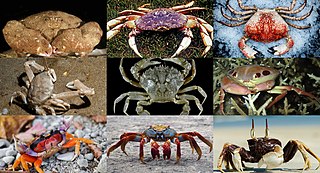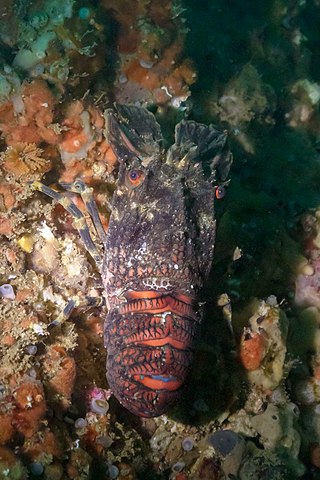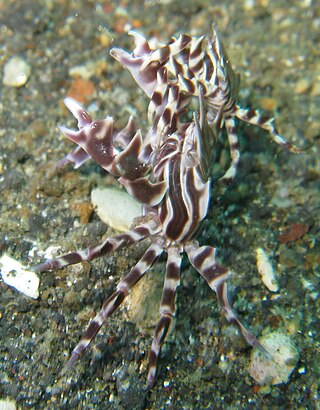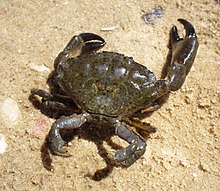
Crabs are decapod crustaceans of the infraorder Brachyura, which typically have a very short projecting tail-like abdomen, usually hidden entirely under the thorax. They live in all the world's oceans, in freshwater, and on land. They are generally covered with a thick exoskeleton. They generally have five pairs of legs, and they have pincer claws on the ends of the frontmost pair. They first appeared during the Jurassic period, around 200 million years ago.

Carcinus maenas is a common littoral crab. It is known by different names around the world. In the British Isles, it is generally referred to as the shore crab, or green shore crab. In North America and South Africa, it bears the name European green crab.

Grapsus grapsus is one of the most common crabs along the western coast of the Americas. It is known as the red rock crab, or, along with other crabs such as Percnon gibbesi, as the Sally Lightfoot crab.

The Smooth Shore Crab is a marine large-eyed crab of the family Grapsidae, found in New Zealand and the Juan Fernández Islands of Chile.

Hemigrapsus sanguineus, the Japanese shore crab or Asian shore crab, is a species of crab from East Asia. It has been introduced to several other regions, and is now an invasive species in North America and Europe. It was introduced to these regions by ships from Asia emptying their ballast tanks in coastal waters.

Scyllarus arctus is a species of slipper lobster which lives in the Mediterranean Sea and eastern Atlantic Ocean. It is uncommon in British and Irish waters, but a number of English-language vernacular names have been applied, including small European locust lobster, lesser slipper lobster and broad lobster.

Pilumnus hirtellus, the bristly crab or hairy crab, is a species of European crab. It is less than 1 inch (25 mm) long and covered in hair. It lives in shallow water and feeds on carrion.

Dromia personata, also known as the sponge crab or sleepy crab, is a species of crab found in the North Sea, the Mediterranean Sea, and connecting parts of the northeastern Atlantic Ocean. Like most other epibenthic crustaceans, the biomass of this species is especially dense in the Mediterranean continental shelf. It mainly resides from the lower shore to a depth of 50 meters (164 ft), often in caves. Occasionally, they are found living in depths as low as 110 meters (360 ft). They serve as prey for octopus, starfish, and other fish. Their last two pairs of legs are positioned dorsally, and are used to hold a sponge in place as camouflage.

Pachygrapsus marmoratus is a species of crab, sometimes called the marbled rock crab or marbled crab, which lives in the Black Sea, the Mediterranean Sea and parts of the Atlantic Ocean. It is dark violet brown, with yellow marbling, and with a body up to 36 millimetres (1.4 in) long. A semiterrestrial omnivore, it feeds on algae and various animals including mussels and limpets.

Xantho hydrophilus, the furrowed crab or Montagu's crab, is a species of crab from the family Xanthidae. It is yellowish-brown and grows to a carapace width of 70 mm (2.8 in). It is a nocturnal omnivore that lives in shallow marine waters from western Scotland to the Cape Verde Islands.

Xantho is a genus of crabs in the family Xanthidae, containing five extant species, all restricted to the north-east Atlantic Ocean and Mediterranean Sea, although Xantho granulicarpis is not universally recognised as a separate species from Xantho hydrophilus:

Guinotellus melvillensis is a species of crabs in the family Xanthidae, the only species in the genus Guinotellus. It is a benthic crab with an ovate carapace within the subfamily Euxanthinae.

Zebrida adamsii is a distinctively striped species of crab that lives in association with a sea urchin in the Indo-Pacific region. It is cryptically coloured with vertical stripes and has special adaptations to its legs to enable it to cling to its host's spines.

Dyspanopeus sayi is a species of mud crab that is native to the Atlantic coast of North America. It has also become established outside its native range, living in Swansea Docks since 1960, the Mediterranean Sea since the 1970s, the North Sea since 2007 and the Black Sea since 2010. It can reach a carapace width of 20 mm (0.8 in), and has black tips to its unequal claws. It feeds on bivalves and barnacles, and is in turn eaten by predators including the Atlantic blue crab, Callinectes sapidus. Eggs are produced from spring to autumn, the offspring reach sexual maturity the following summer, and individuals can live for up to two years. The closest relative of D. sayi is D. texanus, which lives in the Gulf of Mexico; the two species differ in subtle features of the genitalia and the last pair of walking legs.

Pyromaia tuberculata is a species of crab in the family Inachoididae.

Planes minutus is a species of pelagic crab that lives in the North Atlantic Ocean. It is typically less than 10 mm (0.4 in) long across the back, and is variable in colouration, to match its background. It may have been the crab seen by Christopher Columbus on Sargassum weed in the Sargasso Sea in 1492.

Geryon trispinosus is a species of crab that lives in deep water in the north-eastern Atlantic Ocean.
Brachynotus sexdentatus is a species of crab in the family Varunidae. It is native to the Mediterranean Sea and Black Sea, and became established for a time in Swansea Docks. It grows to a maximum carapace width of 18 mm (0.71 in), and lives in shallow water on muddy bottoms.

Latreillia elegans is a species of crab belonging to the family Latreilliidae. This family of crabs is identified by their appearance as small, long-legged crabs. The species belongs to the genus Latreillia which has only five identified species: L. elegans, L. metanesa, L. williamsi, L.valida, and L. pennifera. It was previously thought that L. elegans and L. mannengi were two separate species, but it has since been revealed that the two species are synonymous. All the thought to be differences between L. elegans and L. mannengi were in actuality overlaps. The L. mannengi is simply referring to the close relative to the species of L. elegans found in the western Atlantic.

Libinia spinosa is a majoid crab found in mud and sand bottoms of the Southwestern Atlantic and Pacific oceans. It is a generalist feeder on organisms such as algae, sponges, cnidarians, mollusks, polychaetes, crustaceans, and small fish. It commonly engages in a symbiotic relationship with the medusa Lychnorhiza lucerna.





















